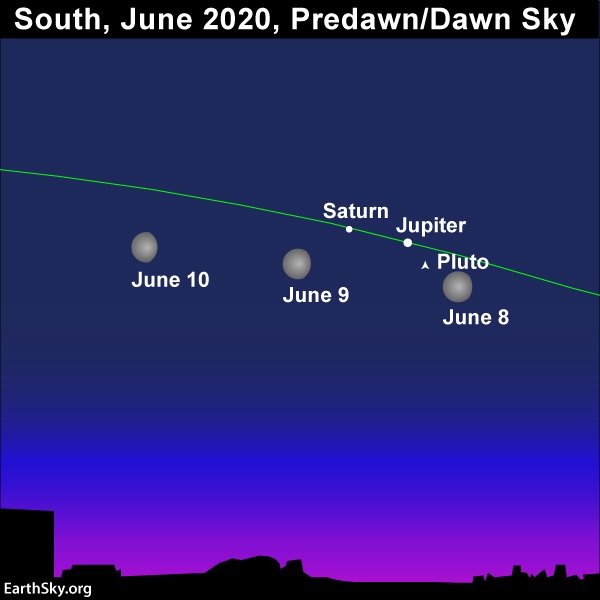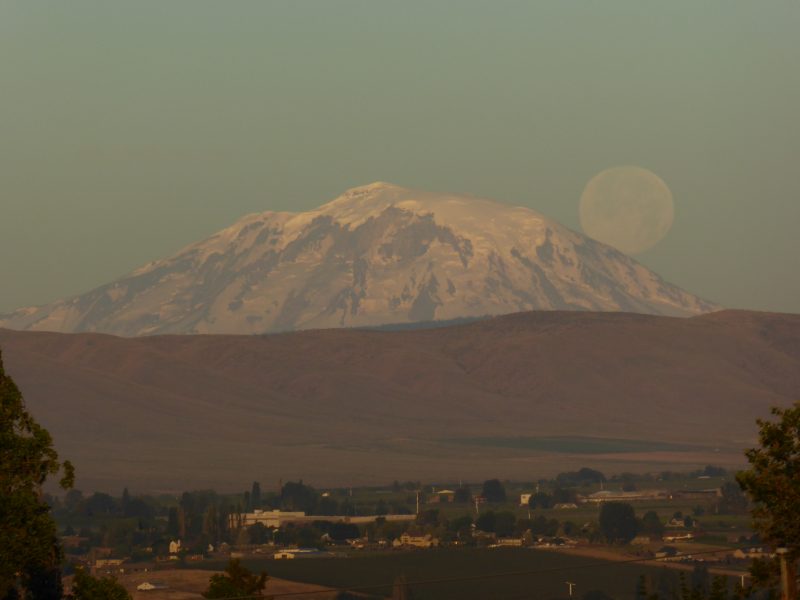Jupiter, Saturn, moon on June 6-8, plus a word about the daytime moon
If you stay up late on the nights of June 6, 7 and 8, 2020, you can glimpse the moon with the bright planets Jupiter and Saturn, ascending in the east. Or see them before daybreak.
Among all the wonderful planet-viewing we’re having in 2020, Jupiter and Saturn hold their own, excitement-wise, by being near one another on the sky’s dome throughout this year. By 2020’s end, they’ll undergo a once-in-20-years great conjunction. This month, and for some months to come, Saturn will closely follow Jupiter westward across the sky. Watch for them in June from mid-to-late evening until dawn. Although Saturn is easily as bright as a 1st-magnitude star, the ringed planet pales next the the king planet Jupiter, which outshines Saturn by some 15 times.
Read more: Before 2020 ends, a great conjunction of Jupiter and Saturn
Try Stellarium-Web for your specific view
After Jupiter and Saturn fade at sunup, look for a daytime moon to remain. No matter where you are on Earth, look generally westward after sunrise to see the moon in a blue daytime sky, assuming your sky is clear.

Why can you see the moon in the daytime now? The full moon – and partial penumbral eclipse – happened on the night of June 5-6, 2020, for the world’s Eastern Hemisphere. In the days after full moon, the moon is officially in a waning gibbous phase, rising in the east after nightfall and setting in a westward direction shortly after sunrise.
If you look for the moon at the same time every morning, you’ll see this week’s waning moon appearing higher and higher in the western sky each early morning, for several days. To understand why, think about where the sun is in early morning. A full moon is opposite the sun, in the west when the sun is in the east. Except now it’s after full moon. The moon is moving in its orbit around Earth – moving toward the east, as it always does – drawing closer and closer to the Earth-sun line.
By June 13, 2020, the moon will be at the last quarter phase – rising around midnight, southward around dawn. Then the moon will turn new on June 21, 2020, to showcase an annular eclipse of the sun. Two weeks after that, there will be a third eclipse – another penumbral eclipse of the moon – on the night of July 4-5. We won’t have three eclipses in one eclipse season again until the year 2029.
Read more: What is an eclipse season?

People love to see the daytime moon. They wonder about it, and ask about it. Once, a reader in Kansas City wrote in with the name children’s moon to describe a moon visible during the day. She said this name stemmed from the idea that children can’t stay up at night late enough to see the moon when it appears only in darkness.
That story prompted another reader to send in an alternate version for the origin of the name children’s moon. She wrote:
I heard a daytime moon was called a ‘children’s moon’ because their eyes were sharp enough to pick it out, where the old folks, with fading vision, could not tell it from the clouds.
Can you see the daytime moon in the next few mornings?


Bottom line: If you stay up late on the nights of June 6, 7 and 8, 2020, you can glimpse the moon with the bright planets Jupiter and Saturn, ascending in the east. Or see them before daybreak.











